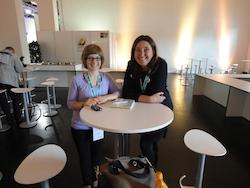Stefana Broadbent, University College London, über die Eigenheiten der digitalen Kommunikation

Pause mit Stefana Broadbent auf dem Medienforum in Köln
Beim diesjährigen Medienforum.NRW in Köln hatte ich Gelegenheit, mit einer wahren Kommunikations-Expertin zu sprechen – im streng wissenschaftlichen Sinn: Stefana Broadbent forscht seit Jahren über die Art und Weise, mit der die digitalen Technologien unser Kommunikationsverhalten verändern. In der Schule, auf der Arbeit und Zuhause. Sie ist überzeugt, dass sie die Menschen näher zusammenbringen, statt sie vor den Bildschirmen zu isolieren. Zurzeit ist sie am neu gegründeten Department of Digital Anthropology des University College London beschäftigt – Jobbezeichnung: Digital Ethnographer. Hier ein Auszug aus unserem Interview.
In your studies, you have found out that the Internet actually enables more intimacy in the way people live and communicate. How is that?
"First of all I should say that I study "normal people“ – not the geeks, not the early adopters. For these normal people, going to work, for example, used to mean very limited contact to the "outside world“. The same goes for people who moved far away from their loved ones. Today, there are so many ways to communicate, whether it’s a short text or a Skype conversation lasting several hours.
Digital communication tools don’t isolate people in front of their computer screens, they actually allow for a new level of proximity, no matter how far the person you want to talk to is away. Just think about mothers who can text their children from work to see if all is going well at home. Or about migrants, who can keep in touch with their families staying behind. One of my students talked to couples who, being separated from each other, even have sex via Skype – they say it’s better than nothing!“
Is there a difference between communication patterns of men and women?
"There is a difference in the usage of communication channels. Everyone uses a wide variety, but different ones are used on different occasions and for different reasons: For example, women prefer text and asynchronous media because they do not interrupt and do not ask for immediate attention. Asking for immediate attention is difficult and we do not do it lightly especially with people we feel have a different status than us – like our bosses or people we do not know well. This also explains the success of E-Mail! Men like texts because they help avoid being dragged into long conversations.
For the same reasons, the channel a person picks in order to contact another can tell us a lot about status and the relationship between them. In a study we interviewed some young women from North Africa living in Paris and found out they would always text their brothers. The brothers would always call the women. One possible explanation is that women learn to give lots of attention to others while growing up – they aren’t necessarily comfortable with requesting lots of attention for themselves. Men don’t have a problem with that.
The communication patterns also suggest that women often have a lesser status than men – especially in business contexts.“
Das Original-Interview ist bei The NextWomen erschienen und ist in voller Länge hier zu lesen.
Auszug aus der Keynote von Stefana Broadbent (Thema "Aufmerksamkeit und Intimität"/"Attention and Intimacy").




